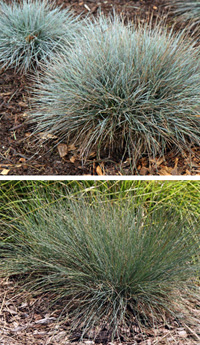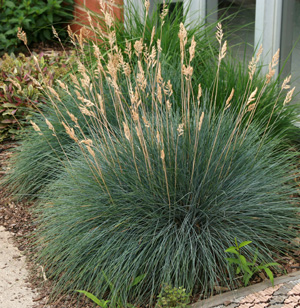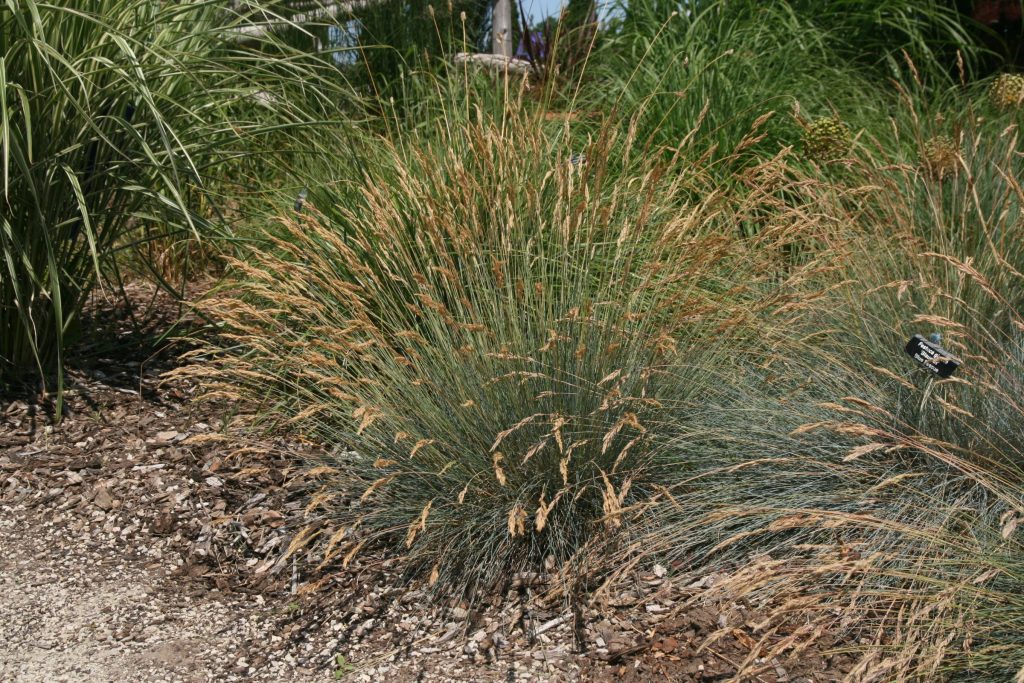Overview of Blue Fescue
Blue fescue (Festuca glauca) is a small cool-season grass native to Europe. Grown as an ornamental for its attractive foliage color, it is hardy in zones 4-8. Fescues are cool season grasses, so they look their best in spring and fall. The foliage of this species is a light blue-silver early in the season, turning to more blue-green in the summer. In fall, it turns a darker mottled green. In mild climates, blue fescue remains evergreen through the winter but may turn brown in harsher winters.
The linear leaves of blue fescue are up to 10″ long and radiate outward from the crown to form a dense clump of very fine textured foliage. The clumps grow 10-12 inches high with a similar spread, only very slowly expanding outward. Even in the snow, the foliage remains mostly upright, providing winter interest.
In early summer, airy inflorescences develop, growing above the foliage to 14-18″ tall. The light green flowers with a purple tinge occur in terminal panicles that eventually turn a buff color. These wispy flower spikes are not highly ornamental and the stalks can be sheared off if desired to improve the appearance of the plant. If the flower spikes are not deadheaded, brown seed heads will form. It easily self-sows and can become weedy.


Landscape Use
Blue fescue can be used as a specimen plant or in a mass planting. It also makes a good filler plant, as it is not as showy as some other ornamental grasses. It can be grown in beds and borders mixed with herbaceous perennials, as an edging plant, in the rock garden among stones or boulders or even in rain gardens. It can be used in containers or troughs to provide a vertical element. Because this is a clumping grass that will not get much larger with age, it should be planted densely (8-10″ apart) if used as a ground cover. The blue color blends well with cool-colored flowers and softens brightly colored flowers.
General Care of Blue Fescue
Blue fescue grows best in full sun and requires well-drained soil. The blue color will not develop as well in partial shade, however. It can be short-lived in wet soils, heavy clay, and in areas with high humidity and temperatures.
Plants should be cut back carefully in early spring to 3-4″ to allow the new growth to emerge, or “comb” out older brown leaves. As the clumps age, the center tends to become crowded and may die, so plants should be dug and divided every 2-3 years, discarding the centers and replanting the more vigorous portions. Blue fescue easily self-seeds.
Blue fescue does not have any significant insect or disease problems and is tolerant of salt spray in the winter. It is also tolerant of juglone, so it does not suffer from black walnut toxicity. Deer and rabbits may graze the foliage.


How to Propagate Blue Fescue
Blue fescue can be grown from seed (realizing that there is a lot of variation in coloration in seed-grown plants), or from clump divisions taken in early spring.
Cultivars of Blue Fescue
There are a number cultivars of this species, although some are not widely available.
- ‘Elijah Blue’ – is the most commonly available variety. It is sometimes listed as a variety of Festuca ovina or Festuca ovina var. glauca. This cultivar has more silvery or sky-blue foliage in spring than the species, with the blue color persisting longer into the growing season.
- ‘Seeigel’ (“sea urchin” in German) – is a compact selection with bright steel blue foliage.
- ‘Boulder Blue’ – is more stiff and upright than ‘Elijah Blue’ with slate blue leaves and better tolerant of heat and humidity.
- ‘Blue Whiskers’ (plant patent 29200) – is taller and more vigorous than ‘Elijah Blue’ with larger leaves and brighter leaf color, growing 10 to 12 inches tall, and 18 to 22 inches tall when in bloom.
- ‘Golden Toupee’ – has a compact habit and vibrant chartreuse foliage.


– Susan Mahr, University of Wisconsin – Madison
Last update: Bruce Spangenberg, UW-Madison Extension, 2025





 ▶︎ Watch: Fall Bulb Planting
▶︎ Watch: Fall Bulb Planting Aster, Symphyotrichum spp.
Aster, Symphyotrichum spp. Fascinating Fasciation
Fascinating Fasciation Alternatives to Lawn: Groundcovers
Alternatives to Lawn: Groundcovers


